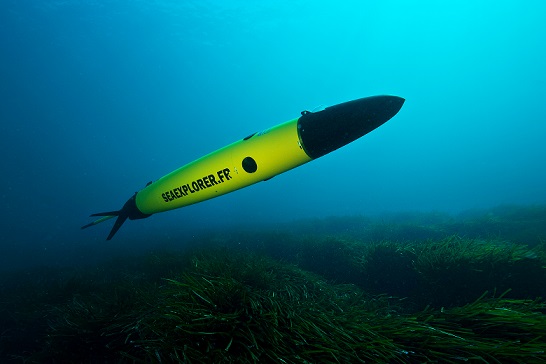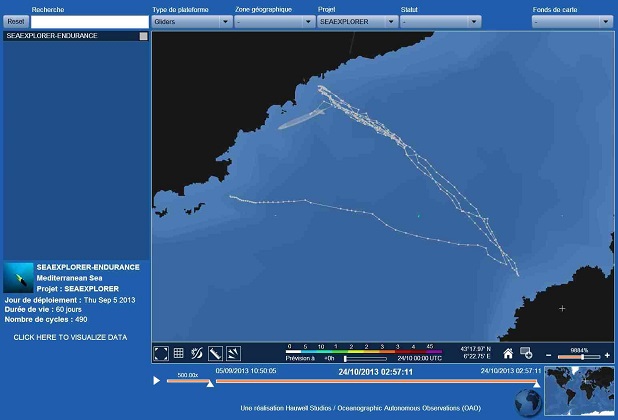SeaExplorer

The SeaExplorer multi-mission platform is an unmanned underwater vehicle developed by ACSA that can navigate at sea for months. The UUV persistently gathers subsea data that is transmitted periodically by satellite telemetry to a ground station located thousands of kilometers away. In 2011 during a previous trial, the glider joined a geo-referenced position 77km away from its deployment zone with only 200 meters error at destination. For defense needs and more especially for support to operations (Rapid Environmental Assessment - REA), are already integrated and available on the SeaExplorer, the Conductivity/Temperature/Pressure (CTD) and Dissolved Oxygen (DO) sensors to define sound velocity profile in order to optimize sonar predictions, acoustic modem communication, and submarine fleet deployment.
Additional on-going developments focus on video camera and passive acoustic payload. The platform has an open-source software & hardware scientific payload, allowing quick implementation of custom sensors. Moreover, its interchangeable payload design enables users to conveniently remove and replace at-sea scientific sections upon sensors required to address specific missions.
Latest News
SeaExplorer Breaks UUV Endurance Record
5 December 2013 - ACSA is pleased to announce that the SeaExplorer glider, developed by ACSA in partnership with ACRI, CNRS and IFREMER, successfully completed a two-month record mission in collaboration with the Laboratoire d’Océanographie de Villefranche (LOV) of National Center for Scientific Research (CNRS) and Pierre and Marie Curie University (UPMC).
"The mission objective was to evaluate the endurance of our first glider equipped with rechargeable batteries while performing several round trips between France and Corsica Island" said Dr. Hervé Claustre of the CNRS LOV. Indeed, although all gliders on the market traditionally use alkaline or primary Lithium batteries, ACSA is the first glider’s manufacturer to introduce rechargeable Li-Ion batteries as an effective, reliable and affordable solution for the market. "The SeaExplorer glider has also acquired a wealth of high resolution data along its transects whose results will be presented by LOV at the Ocean Science Meeting in Honolulu Hawaï in February 2014" said Dr Claustre. The LOV team is now planning in the coming weeks the next deployment of this new sensing platform with additional biogeochemical sensors (e.g. Chlorophyll fluorescence, backscattering).

Launched on September 5th 2013, LOV scientists recovered their glider on Tuesday the 5th of November at 11:30 at Bay of Angels on the French Riviera. Completing a two-month mission, the SeaExplorer glider became the first glider to break a double world record for multi-sensors Unmanned Underwater Vehicle (UUV) with rechargeable batteries.
Reaching the milestone of 60 days and a total of 1,183 kilometers on a single battery charge, the SeaExplorer glider has successfully set a duration and distance record. Launched south of Nice, SeaExplorer averaged 0,5 knots and provided over 1,168 profiles of the water column from near surface to 500 meters depth with 100% communications even in high sea-states. Supervised by satellite telemetry from onshore office using ACSA’s IRIS software, the performance was manually stopped whereas internal parameters indicated 18% of its battery energy remaining.
The success of this world’s longest mission performed by a rechargeable powered UUV highlights the reliability of the SeaExplorer glider. Besides the platform’s endurance record, the scientific payload was equipped with SeaBird pumped CTD (Conductivity/Temperature/Depth) and Dissolved Oxygen sensors recording continuously at 4 seconds inter-sample time (metric resolution) for a total of 90 Mo. First comparisons of the SeaExplorer dataset with simultaneous profiles from a ship-borne CTD-rosette show very good data quality, even across strong temperature gradients.
From the French Operating Gliders Center (CNRS DT/INSU), Laurent Beguery, expert consultant for ACSA, said: "I am delighted with SeaExplorer performing 8 weeks and setting this record. The performance of the endurance test is clearly a success. This means that this first rechargeable glider is now mature enough to represent a reliable alternative to alkaline and primary Lithium powered gliders. I personally do appreciate that this type of glider avoids operations of batteries replacement every 2 to 4 months and reduces, to 20 hours only, immobilization time for refueling at the workshop. In other words, for scientists, it makes lots of savings in materials replacement, technician man-hours as well as for ballasting time and hopefully increases the Mean Time Between Failures (MTBF)."
To understand the unique capability of rechargeable as a major step forward in the challenge to increase cost-effectiveness of gliders operations, Patrice PLA, Sales & Marketing Director comments: "Out of ten months of at-sea operations per year, rechargeable batteries not only grant higher availability rate but also reduce operating costs between 75,000 to 150,000 Euros per glider over 5 years compared to alkaline and primary Lithium batteries traditionally used by scientists."
See also:
Autonomous Submarine Drones: Cheap, Endless Patrolling
China's gliders: Haiyan & Sea Wing